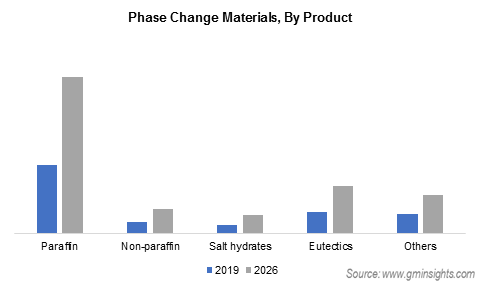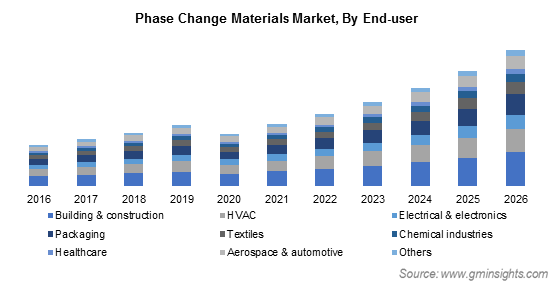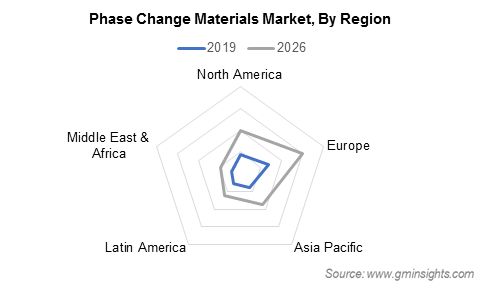Home > Chemicals & Materials > Advanced Materials > Functional Materials > Phase Change Materials Market
Phase Change Materials Market Size, By Product (Paraffin, Non-Paraffin, Salt Hydrates, Eutectics), By End-user Sector (Building & Construction, HVAC, Textiles, Chemical, Healthcare, Aerospace & Automotive), Industry Analysis Report, Regional Outlook, Application Potential, Price Trends, Competitive Market Share & Forecast, 2020 – 2026
- Report ID: GMI2241
- Published Date: Aug 2020
- Report Format: PDF
Phase Change Materials Market Size
Phase Change Materials Market size was valued at around USD 1.9 billion in 2019 and will exhibit a growth rate of over 17.4% from 2020 to 2026. The growth of the e-commerce industry along with increasing investments in innovative packaging trends, particularly for food materials, will augment the demand for PCM in the packaging sector throughout the assessment period.
Phase change materials are products that store, release, and absorb heat as they oscillate between liquid and solid forms. They are also known as latent heat storage materials as they can store large amounts of thermal energy as latent heat during phase transition.

The global phase change materials (PCMs) market will be primarily driven by the escalating growth in both the construction and packaging industries. In the construction industry, PCMs are used for solar water heating, space heating/cooling, and waste heat recovery systems, among others. The growing investments in the construction industry across the globe coupled with the adoption of phase change materials in Heating, Ventilation and Air-Conditioning (HVAC) applications are projected to amplify its demand throughout the forecast period. Furthermore, the packaging business is also anticipated to generate substantial revenue gains during the forecast period.
The growing innovations in the global PCM market share will also generate quite some revenue gains during the forecast period. With the growing advancements in encapsulation technologies, the market has witnessed various new ways of PCM incorporation in a wide range of products. Phase Change Material (PCM) encapsulation is the process of integrating PCM into end products such as building materials, textile fibers, and others. Microencapsulation and macroencapsulation are advanced methods of incorporating PCM into the final product. The growing adoption of these types of encapsulation has resulted in the widespread use of phase change materials with different melting points and in various forms from fibers to raw powder.
These innovative trends in the market along with the ongoing investments by proficient players are projected to open up new opportunities during the review period. Furthermore, the rising popularity of biobased phase change materials owing to their environmental and safety benefits will also propel the phase change materials market demand in the coming years.
| Report Attribute | Details |
|---|---|
| Base Year: | 2019 |
| Phase Change Materials Market Size in 2019: | USD 1.9 Billion |
| Forecast Period: | 2020 to 2026 |
| Forecast Period 2020 to 2026 CAGR: | 17.4% |
| 2026 Value Projection: | USD 4.4 Billion |
| Historical Data for: | 2016 to 2019 |
| No. of Pages: | 336 |
| Tables, Charts & Figures: | 499 |
| Segments covered: | Product, End-user, Region |
| Growth Drivers: |
|
| Pitfalls & Challenges: |
|
Major manufacturers, such as Croda International and Laird International, produce and market phase change materials exclusively made from renewable agricultural resources and not crude oil or petroleum. Biobased PCMs have special demand from temperature-controlled packaging mainly in the pharmaceutical sector and are highly desirable by manufacturers to market their products in a packaging that will not affect the product and are bio-degradable.
However, the high production cost of phase change materials and volatile prices of raw materials are some of the major barriers to the phase change materials market growth. Crude oil is the major raw material and is subjected to huge volatility in prices. A slight change in the global oil scenario will directly affect the price of phase change materials, restraining the overall market.
Phase Change Materials Market Analysis

Paraffin constituted approximately 53% of the total phase change materials market share in 2019 in terms of revenue and is likely to witness a gain of 18.3% during the forecast timeframe. Paraffins show good storage density with respect to mass & melt and solidify congruently with little or no sub-cooling. Their thermal conductivity is however comparatively low. Paraffins have melting temperature ranges that are suitable for a range of applications as they possess high latent heat, have good thermal characteristics, and are chemically & thermally stable.
Paraffinic hydrocarbons are widely used in textiles than other PCMs due to their excellent characteristics such as non-corrosive, thermal & chemical stabilities, and low undercooling. Paraffins have low solubility in water; hence, are highly used in building materials and they exhibit melting enthalpies between 150 and 220 KJ/Kg.
The other phase change material market segment is projected to exhibit a CAGR of over 14.9% during the review period. Other phase change materials primarily include biobased phase change materials. They are non-toxic and are made from biodegradable raw materials. They are hydrogenated hydrocarbons that are chemically stable and can last for a longer duration. These are generally made from vegetable oils, waxes, and fruit oils. Biobased PCMs can provide price/performance characteristics that superior to paraffin PCM chemicals.

The building & construction sector held a market share of over 23% in 2019. The rising investments in research & development activities and emerging technologies in macro and microencapsulation are anticipated to create lucrative opportunities for the phase change materials market in the building & construction industry. The usage of adequate thermal energy storage systems in the building & construction sector offers high potential in energy conservation. Furthermore, PCMs are widely used in construction materials through different techniques.
Some of the most commonly used methods are immersion, direct incorporation, microencapsulation, encapsulation, and shape-stabilization. Increasing product applications in building & construction activities will spur the PCM market in the coming years.

Europe held the largest share of 30% in the global PCM market in 2019. It is primarily due to advanced construction practices in Europe and the growing demand for HVAC systems in residential houses. The integration of phase change materials into heating systems and ventilation will considerably affect the room temperature. Europe experiences cold weather conditions; hence, good HVAC systems are needed all around the year, which will eventually create demand for phase change materials.
Phase Change Materials Market Share
The industry is fairly competitive with presence of various global and domestic suppliers in the value chain. Some of the key product producing companies in the phase change materials industry include:
- Phase Change Products Pty Ltd
- Henkel
- Cryopak
- BASF SE
- Entropy Solutions LLC
- Laird Plc
- Sasol
- The Dow Chemical Company
- Croda International Plc.
Phase change materials market report includes in-depth coverage of the industry with estimates & forecast in terms of volume in Kilo tons & revenue in USD million from 2015 to 2026, for the following segments:
Click here to Buy Section of this Report
By Product
- Paraffin
- Non-paraffin
- Salt Hydrates
- Eutectics
By End-user
- Building & Construction
- HVAC
- Electrical & Electronics
- Packaging
- Textile
- Chemical Industries
- Healthcare
- Aerospace & Automotive
- Others
By Region:
- North America
- U.S.
- Canada
- Europe
- Germany
- UK
- France
- Italy
- Spain
- Russia
- Asia Pacific
- China
- India
- Australia
- Japan
- Indonesia
- Malaysia
- South Korea
- Latin America
- Brazil
- Mexico
- Middle East & Africa
- South Africa
- Saudi Arabia
- UAE
- Kuwait
